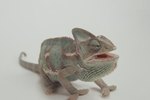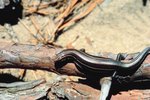
Snake and lizard species together populate Squamata, the largest order of reptiles. The word “Squamata” means “scaly” in Latin, and the order includes both legged and legless reptiles. Over 7,000 species, approximately 95 percent of the world’s reptiles, are squamates. Although squamate species are more diverse than mammals, they can all trace their lineage back to one common ancestor that roamed the earth approximately 200 million years ago.
Reproductive and Sensory Organs
Many squamates, including both lizards and snakes, have a Jacobson’s organ on the roofs of their mouths. This sense organ detects chemicals in the air, picked up by the squamate’s flicked tongue. Often compared to the mammalian sense of smell, this is one way lizards and snakes locate prey. Male lizards and snakes also have two copulatory organs called hemipenes. These duplicate organs are located at the based of the animal’s tail and are used independently.
Skeletal Structure
All squamates are vertebrates, and despite their relative flexibility both lizards and snakes have backbones. Squamates have flexible skulls and relatively elastic jaws that distinguish them from other reptiles. The quadrate bones that make up part of the jaw joint move separately from the squamate’s skull, allowing it to open its jaws very wide compared to other animals. Snakes' jaws are much more flexible than those of lizards, however, allowing them to swallow prey whole that is several times their size.
Skin
As the order name suggests, both snakes and lizards have the same scaly skin. The outer layer of the squamate’s skin is composed of side by side and overlapping scales that do not grow with the animal. Rather, this dry outer layer is dead and must be shed periodically as the squamate grows. Lizards with legs shed their old skin in pieces. Legless lizards and snakes shed their skins at once, sliding out of the old skin like an arm out of a sleeve.
Thermoregulation
Like all other reptiles, both snakes and lizards are cold-blooded or ectothermic. They must use external heat sources to control their own body temperature, and all squamates use similar behavior for thermoregulation. Snakes and lizards will bask in the sun to warm their bodies and retreat into the shade or under rocks to cool down. The animals expand, flatten and angle their bodies towards or away from the sun to alter the portion of their bodies exposed to the sun’s rays and the amount of heat being absorbed.
References
Photo Credits
-
Comstock/Comstock/Getty Images
Writer Bio
Jennifer Mueller began writing and editing professionally in 1995, when she became sports editor of her university's newspaper while also writing a bi-monthly general interest column for an independent tourist publication. Mueller holds a Bachelor of Arts in political science from the University of North Carolina at Asheville and a Juris Doctor from Indiana University Maurer School of Law.




